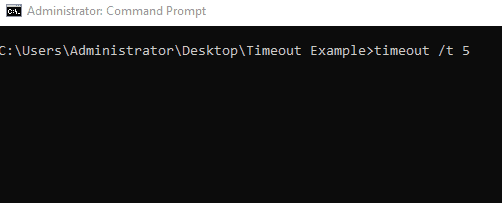Batch set command timeout
This article will first discuss the concept of timeout command in batch scripting. After that, we will discuss setting timeout command for any other command.
Timeout command in batch script
A timeout is a utility that pauses or delays for a specific period of time. This command takes a certain amount of time out and creates a pause on the command line interface.
The syntax of the timeout command is as follows:
timeout /t <time in seconds> [/nobreak]
The command /ttimeout is used to create a delay, followed by <以秒为单位的时间>(an integer from -1 to 100000 representing the amount of time in seconds to create the delay), and optional parameters /nobreak.
If we use -1 with the timeout command, it will produce an indefinite delay until any key is pressed.
Consider the following timeout command:
timeout /t 5
The timeout /t 5 command delays for 5 seconds or until no key is pressed. The command output is as follows:

The optional parameter /nobreak is used to ignore any keystrokes during the delay created by the timeout command. For example, consider the following command:
timeout /t 5 /nobreak
The output of the following command is as follows:

We can also hide the timed out command message. command timeout /t 5 > nulis used to hide the message of timed out command by redirecting the output message to nul.
Set a timeout for any other command or process
We can delay the timeout of any other custom command or process. Consider the following batch script:
@echo off
start notepad.exe
timeout /t 4
taskkill /f /im notepad.exe > nul && (
echo Task is killed.
exit /b 31744
) || (
echo No Command or Task to kill. The task is terminated in time.
)
In the above batch script, we use @echo off command to hide the command being executed from the command prompt. start notepad.exeThe command is used to start the process and launch the Notepad editor window.
The command timeout /t 4delays for 4 seconds and then executes the taskkill command, which kills the notepad.exe process if it has not already been killed.
Additionally, the script displays that the task has been terminated. If the taskkill command terminates the notepad.exe process, it is displayed on the terminal.
If notepad.exe is terminated during the timeout delay, the taskkill command will not terminate notepad.exe and will display an error message with the following output:
There was no command or task to kill. The task was terminated in a timely manner.
For reprinting, please send an email to 1244347461@qq.com for approval. After obtaining the author's consent, kindly include the source as a link.
Related Articles
How to decompress x.tar.xz format files under Linux
Publish Date:2025/04/08 Views:186 Category:OPERATING SYSTEM
-
A lot of software found today is in the tar.xz format, which is a lossless data compression file format that uses the LZMA compression algorithm. Like gzip and bzip2, it supports multiple file compression, but the convention is not to compr
Summary of vim common commands
Publish Date:2025/04/08 Views:115 Category:OPERATING SYSTEM
-
In Linux, the best editor should be vim. However, the complex commands behind vim's powerful functions also make us daunted. Of course, these commands do not need to be memorized by rote. As long as you practice using vim more, you can reme
Detailed explanation of command return value $? in Linux
Publish Date:2025/04/08 Views:58 Category:OPERATING SYSTEM
-
? is a special variable. This variable represents the return value of the previous command. That is to say, when we run certain commands, these commands will return a code after running. Generally, if the command is successfully run, the re
Common judgment formulas for Linux script shell
Publish Date:2025/04/08 Views:159 Category:OPERATING SYSTEM
-
In shell script programming, predicates are often used. There are two ways to use predicates, one is to use test, and the other is to use []. Let's take a look at how to use these two methods through two simple examples. Example 1 # test –
Shell script programming practice - specify a directory to delete files
Publish Date:2025/04/08 Views:98 Category:OPERATING SYSTEM
-
Usually, in Linux system we need to frequently delete some temporary files or junk files. If we delete them one by one manually, it will be quite troublesome. I have also been learning shell script programming recently, so I tried to write
Use of Linux command at - set time to execute command only once
Publish Date:2025/04/08 Views:158 Category:OPERATING SYSTEM
-
This article mainly involves a knowledge point, which is the atd service. Similar to this service is the crond service. The functions of these two services can be similar to the two functional functions of javascript. Those who have learned
Use of Linux command crontab - loop execution of set commands
Publish Date:2025/04/08 Views:170 Category:OPERATING SYSTEM
-
Compared with at , which executes a command only once, crontab, which we are going to talk about in this article, executes the set commands in a loop. Similarly, the use of crontab requires the support of the crond service. The service is s
Linux practice - regularly delete files under the directory
Publish Date:2025/04/08 Views:198 Category:OPERATING SYSTEM
-
Since we want to delete the files under the directory regularly, we need to use the Linux crontab command. And the content format of each work routine is also introduced in the format of each crontab work. Similarly, we need to use shell sc
How to use the Linux file remote copy command scp
Publish Date:2025/04/08 Views:151 Category:OPERATING SYSTEM
-
Scp copies files between two hosts over the network, and the data is encrypted during transmission. Its underlying layer uses ssh for data transmission. And it has the same authentication mechanism and the same security level as ssh. When u

